Checkout-free technology is advancing quickly, with the likes of Amazon and Albert Heijn investing heavily. So what challenges remain – and could these ‘miracle’ stores soon be commonplace?
The future of grocery retail can be found in a shipping container at Schiphol Airport, Amsterdam. Inside the black metal box is Dutch supermarket giant Albert Heijn’s new concept convenience store. There are no cashiers, no checkouts, not even a self-scanning device or app. Customers scan their payment card at the entrance, pick from 70 SKUs, and leave.
“This is ultimate convenience, like taking things from your own fridge,” says Jasper Hoogers, Albert Heijn’s manager of instore digital.
The 14 sq m store – soon to be lifted on to the back of a truck and whisked to a new location – represents a truly “frictionless” customer experience, says Hoogers.
The experience is enabled by a combination of vision software, which monitors a shopper’s position in store, and more analogue techniques like scales built into shelves that detect when they are an item lighter. As one awestruck shopper put it: “It automatically recognises what you pick up – that’s a miracle, right?”
If retailers like Albert Heijn can pull it off, and at scale, the checkout could soon be consigned to history.
Retailers are salivating at the prospect. No checkouts mean no queues. A 2018 Forrester study of US supermarket customers found they rated line length as the least satisfying part of their shopping experience. Queues that are too long see 18% shop elsewhere in future, the biggest turn-off after location and price.
No checkouts means fewer staff, lowering costs and extending opening hours. As Albert Heijn CEO Marit van Egmond puts it: “The store can always be open.”
But just how realistic is the prospect of customers simply leaving a store after their shop, without interacting with even a self-scan terminal, let alone a cashier? Does the promise of checkout-free stores check out?

In practice: using Albert Heijn’s Digitale store
-
To enter the store you first need to scan a payment card
-
There are about 70 SKUs from which to choose
-
Cameras and shelf sensors detect when you pick an item off a shelf
-
When you have everything you need, you check the list, and are charged on exit
Frictionless technology
The technology is advancing fast. Amazon, a pioneer in the field, has already opened 24 of its checkout-free Amazon Go stores dotted around Seattle, Chicago, New York and San Francisco. Two more are coming soon. The ‘Just Walk Out Shopping Experience’, which Amazon says is enabled by the “same types of technologies used in self-driving cars” allows shoppers to scan their phone on arrival, fill their bags, then walk out. A receipt arrives “a little later”.
The tagline for the autonomous stores, which offer a small range of groceries and meal kits, reads “No lines, no checkout. No, seriously”.
In the case of Albert Heijn’s “digital store”, the miracle tech comes from AiFi, a startup founded by former Google and Apple researchers. It opened the “world’s first autonomous gas station store” in December in Campbell, California, under the Loop brand. Carrefour partnered with AiFi to launch a similar store at its headquarters in Paris late last year. Polish convenience retailer Zabka, and Swiss chain Valora, have AiFi-powered stores planned too.
“Shopping transactions at these stores can be completed in seconds,” says Steve Gu, AiFi’s co-founder. It is, he adds, “the most efficient shopping experience”.
The promise of such an experience has seen millions of dollars flood into the sector over the past year.
In October, Tesco announced it had made an equity investment in Israeli frictionless checkout startup Trigo. A test site has now been established within the supermarket’s Welwyn Garden City headquarters.
“Frictionless shopping is a good example of Tesco using applied technology in a way that simplifies the shopping trip,” says Jo Hickson, head of Tesco Labs.
As with other frictionless stores, items are automatically added to a digital shopping basket as they are chosen by the customer.
“Colleagues in the store have enjoyed the buzz that naturally comes when we test the latest technology. They’ve been keen to give it a go and get involved.”
Elsewhere, startup Zippin, which opened a check-out-free demonstration store in San Francisco in 2018, has since inked a deal with one of Brazil’s biggest retail groups, Lojas Americanas SA. Another provider, Standard Cognition, is “installing systems for multiple retailers around the world” but is yet to name them; while rival Grabango in July announced a partnership with US grocer Giant Eagle to create a “no-wait checkout experience”. Inokyo is operating a prototype store near its base in California.
Who took what?
Each provider’s solution works in a similar way. The main challenge is figuring out who took what.
A store is fitted out with cameras that provide a total view of the retail space, and scaled shelves monitor the weight of the items they are holding. The clever bit happens at the software level. Deep learning – a type of machine learning technique – is applied to the camera feeds. People moving around the store are labelled and tracked, as are any objects they pick up. When it appears a customer’s arm is reaching for a shelf and taking an item, it is linked to any change in weight on the shelf. Many providers call this “sensor fusion”.
Beyond the obvious benefits of better customer experience and fewer cashiers, the set-up also allows for a greater level of data collection, says AiFi’s head of partnerships Liu Yang.
“There’s insight from when someone enters the store but doesn’t buy anything. Or picks up a can of cola but puts it back. Those data points are not just not captured in brick-and-mortar stores,” Yang says.
There are significant limitations, though. All examples to date have been small, offering a limited number of easily distinguished SKUs.
AiFi’s Loop service station has 1,500 SKUs. Amazon Go stores stock just over 1,000 items, which must remain well-ordered, often with fixed compartments for specific items to go. The stores always look tidy, because they must be to function.
Trigo and Grabango are hoping to make their technology work in supermarket-sized stores, but are not there yet. “We believe that our path will prove to be much more scalable. The business problem is large stores, not tiny boxes in an airport,” says Trigo marketing chief Ran Peled. Its solution will be less reliant on shelf placement, he adds. “It’s not how a normal supermarket operates,” he says, but that will take longer to develop. “They [Tesco] are operating in demo mode. The technology is fitted. But it takes more time to open the first one because it’s a bigger challenge.”
“At any given time we have a number of innovative and exciting trials going on. It’s important we keep testing concepts”
For now at least, the technology is incredibly expensive. Even Amazon appears to be struggling to make it add up. Bloomberg in November reported the Go project had cost more than a billion dollars, with store sizes significantly downgraded from initial ambitions. In September, The Information reported Amazon Go’s operating losses would swell to $58m in 2020, with the number of openings falling well short of initial projections. There has been talk of Amazon licensing the technology for other brands to use.
Most providers of the tech can so far only claim 99% accuracy. “That’s pretty bad,” says Christian Floerkemeier, chief technology officer at barcode scanning solution firm Scandit. “Ninety-nine point five per cent is not good enough. There’s a lot of money in that 1%.” And that 99% has only been achieved in small stores with carefully selected merchandise.
Sceptics have been circling. Former Walmart head of checkout innovation Joel Larson called Go “just a fairytale for retailers that actually want to make money”. Even the tech’s backers are cautious. “This is a long-term technology play,” says Tesco’s Hicks, “and at any given time we have a number of innovative and exciting trials going on. It’s important we keep testing concepts.”
‘Just Walk Out’ tech is not the only innovation threatening the checkout. A wall of handheld scanners for shoppers to ring up items as they shop has become a common feature of supermarkets around the world.
Waitrose was the first UK supermarket to introduce the devices and others have since followed suit. Customers using Scan & Go in Asda “take half the time to check out, and there are fewer queues” says Asda. Sainsbury’s SmartShop is available in 525 stores after 450 locations came online in 2019. “And by the end of the year we’ll be saying 100% of all stores,” says Michele Swaine, Sainsbury’s head of digital product.
On average, 15% of sales now go through SmartShop in stores where handsets are available. While users benefit from not having to rescan their items and queue, supermarkets also gain. Shoppers using devices and apps get a running total of their shop.
“We wondered if they would spend a bit less. But – and we now have a year of data – we found they’re actually spending more,” Swain says. “Now they can track spend as they’re going, they’re saying ‘I can take that extra one or nicer one’. They can manage their budget and therefore spend up.”
Many mults have brought the same functionality as the handsets to their mobile apps. “It’s a way of deploying and realising customer convenience without very large risks on the commercial and technology side,” says Floerkemeier, whose company supplies the barcode reading capability to many supermarket apps.
The final pain point
Typically, those that scan in the aisles must still go to a checkout, dedicated or otherwise, to pay. But that remaining pain point is beginning to be removed by adding the ability to pay in-app – via Apple Pay or Google Pay – as well.
In 2018, in what it called a “UK supermarket first”, Sainsbury’s trialled the feature at its Clapham North Station Local store. In-app payments make it “super-quick for customers to get in and out of the store” said Sainsbury’s group chief digital officer Clodagh Moriarty at the time. It is now available in eight stores.
In October that year, M&S rolled out its Mobile, Pay, Go app across six London stores. Tesco has made in-app payments available to 5,000 employees. Co-op launched ‘Pay in aisle’ to 30 stores in a trial starting in July. “As long as it doesn’t make things more difficult or slower for customers, that’s a mark of success,” it said.
Customers are making positive noises. “Those using SmartShop are more loyal to us now because they like that convenience. If we get them past the first and second times using it then they really don’t look back,” says Swaine.
“As long as it doesn’t make things more difficult or slower for customers, that’s a mark of success”
Might mobile scan, pay and go mark an even sooner end for the checkout? Sainsbury’s success story comes with a tale of caution. In April, it launched the “UK’s first till-free grocery store” at Holborn Circus. Customers’ only option was to scan and pay in the SmartShop app. Although always an “experiment rather than a new format for us” the supermarket had high hopes. It summarised the findings: “It’s clear that not all our customers are ready for a totally till-free store.”
Swain says the company plans to “keep testing, experimenting, iterating and improving”. “It’s all about experimenting, seeing how customers respond, and making sure they’re ready while we’re learning as well,” she says.
Ultimately, customers will determine if the checkout has a future in the face of new technologies.
Hicks says Tesco will “see how customers respond, before deciding what comes next”.
“We’ll keep testing new ideas, thinking carefully about how technology is applied and checking it benefits customers. When these ideas are fully developed and are proven to provide value to customers we will consider going further.”
Does checkout-free mean cash-free?
Whether it’s done in an Amazon Go-style store or with a supermarket’s self-scanning mobile app, checkout-free shopping is not conducive to paying with cash. Does that matter?
Banking industry body UK Finance predicts that by 2028 61% of all payments will be made by card. Cash use will continue its “long-term decline” and be used in only 9% of transactions by the end of the decade, the group says.
Debit cards alone already account for almost three in five store transactions, according to the BRC. Cash was used in just over half of all transactions in 2013, but less than 40% in 2018.
In-app payments – via Google Pay, Apple Pay or Samsung Pay – are a small but growing category, which Juniper Research forecasts will make up 15% of contactless transaction value this year.
Cash is even less frequently used in certain stores. Sainsbury’s said at the Holborn Circus store it piloted checkout-free, 82% of transactions were cashless.
But refusing to accept cash is risky. This month Tesco copped criticism for saying it will no longer accept cash at its Scan As You Shop terminals, even though 90% of shoppers pay at them with card. Asda’s Scan & Go option is similarly card-only.
Five checkout-free stores from around the world
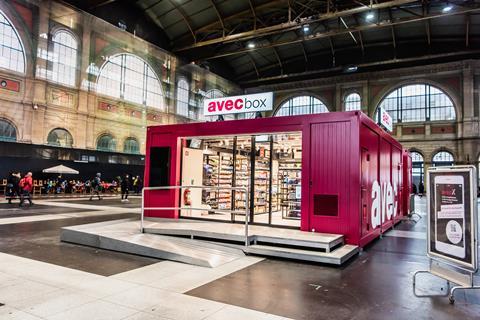
Valora
Swiss company Valora launched a cashier-free convenience store Avec Box at Zürich Central Station in April last year, which has since moved to a nearby university campus.
Shoppers download an app, which they use to open the door to the store and scan items they pick up within. Payment is done through the app as well.
“The entire shopping experience can be done even more comfortably, at your own pace and outside normal opening hours,” Valora says.
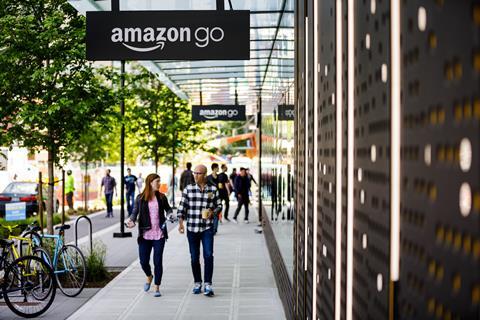
Amazon Go
Amazon Go’s first store opened at its HQ in 2016, initially only to employees.
The public opening in 2018 was reportedly delayed due to issues around tracking multiple shoppers and dealing with people picking up items and putting them down on a different shelf.
There are now 24 Go stores in four cities. Late last year Amazon confirmed it is launching a chain of large grocery stores separate to its Whole Foods Market venture, which will use conventional checkouts and not Go tech.
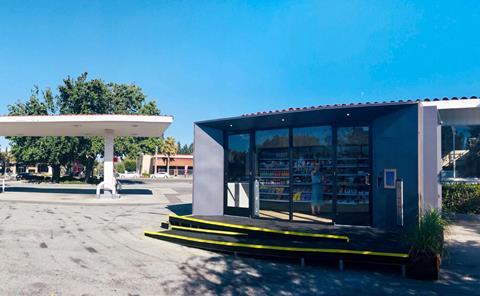
Loop Neighborhood
The Loop convenience store by AiFi is situated next to a Shell petrol station in Silicon Valley and open 24/7. Customers swipe their card to enter, select from around 1,500 SKUs and then walk out.
“The fast, frictionless process is delightful and helps customers get what they need to move on with their day,” says Loop Neighborhood.
The two companies have more locations for the format planned and hope to deploy the technology in a much larger store.

Coop Denmark
Coop Denmark last year put its own spin on the checkout-free concept: a store that is manned during the day and switches to autonomous mode between 11pm and 7am.
During those times, customers use an app to enter, scan items and pay.
Self-scanning with a smartphone was launched across 1,150 stores in Denmark and Greenland last year. The scanning app has been downloaded 1.6 million times and is used by 250,000 people daily for an average of four minutes.
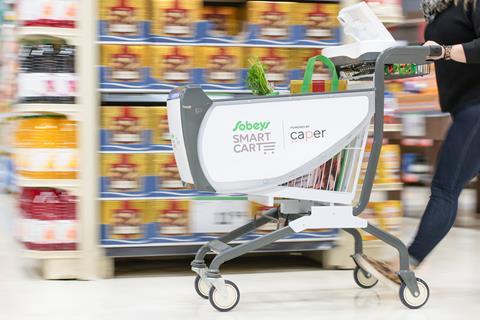
Sobeys
Canadian grocery chain Sobeys in October introduced “the first intelligent shopping cart” to one of its stores.
Customers scan item barcodes as they put them in the trolley. Its maker Caper says the cart will soon be able to identify items with built-in high-resolution cameras.
“Supported by the cart’s sensitive weight measures, customers will eventually be able to toss their items into the cart without having to enter any information or scan barcodes,” Sobeys says.







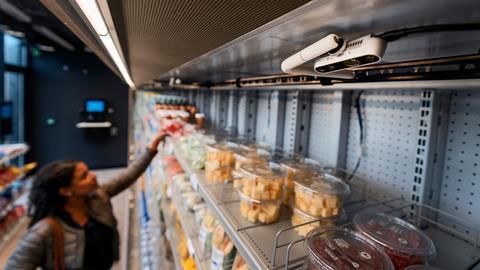
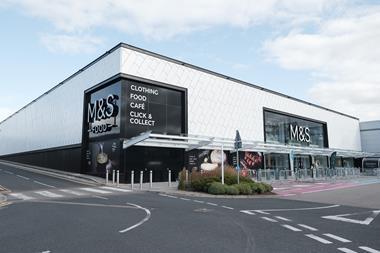
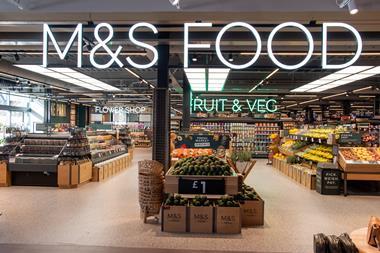

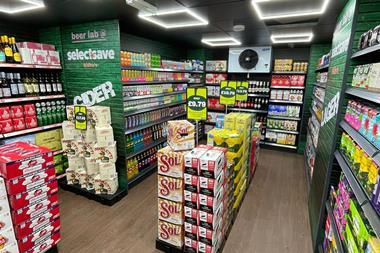
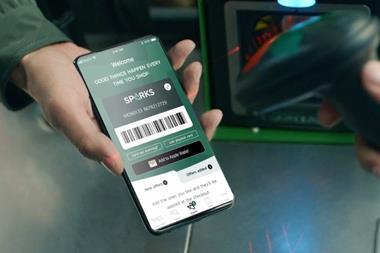







No comments yet